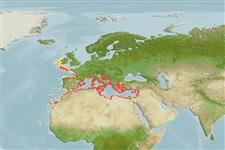Classification / Names
Common names from other countries
Main reference
Size / Weight / Age
Max length : 100.0 cm TL male/unsexed; (Ref. 3397); common length : 50.0 cm TL male/unsexed; (Ref. 3688); max. published weight: 14.3 kg (Ref. 40637)
Length at first maturity
Lm 34.6 range ? - ? cm
Environment
Marine; benthopelagic; depth range 0 - 200 m (Ref. 3688), usually 15 - 50 m (Ref. 54220)
Climate / Range
Subtropical, preferred 19°C (Ref. 107945); 56°N - 12°N, 23°W - 42°E (Ref. 54220)
Distribution
Eastern Atlantic: British Isles to Cape Blanc, Mauritania; (exceptionally further south) Senegal and around the Canary Islands and Madeira. Common south of 40°N (Spain, North Africa) in the Mediterranean (Ref. 4781).
Countries | FAO areas | Ecosystems | Occurrences | Introductions
Short description
IUCN Red List Status (Ref. 115185)
Threat to humans
Harmless
Human uses
Fisheries: commercial; aquaculture: commercial; gamefish: yes
More information
ReferencesAquacultureAquaculture profileStrainsGeneticsAllele frequenciesHeritabilityDiseasesProcessingMass conversion
Tools
Special reports
Download XML
Internet sources
Estimates of some properties based on models
Phylogenetic diversity index
PD50 = 0.5001 many relatives (e.g. carps) 0.5 - 2.0 few relatives (e.g. lungfishes)
Trophic Level
4.5 ±0.4 se; Based on diet studies.
Resilience
Low, minimum population doubling time 4.5 - 14 years (K=0.1; tm=2-3)
Vulnerability
High to very high vulnerability (66 of 100)
Price category
